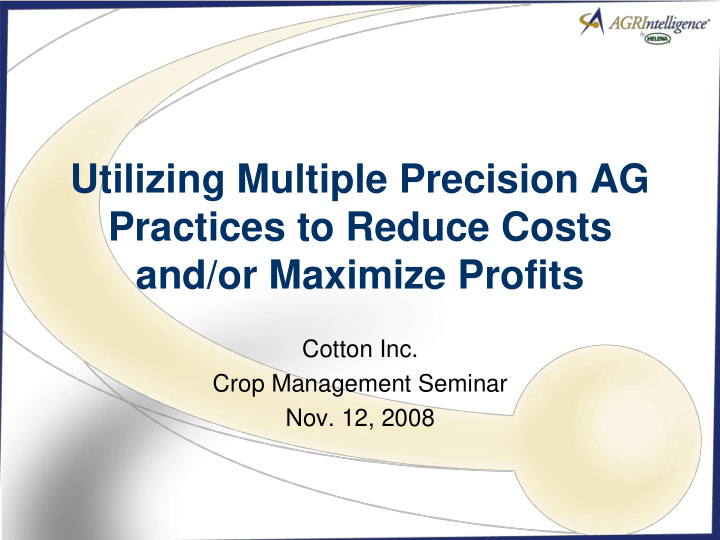



Utilizing Multiple Precision AG Practices to Reduce Costs and/or Maximize Profits Cotton Inc. Crop Management Seminar Nov. 12, 2008
Topics • Which technologies are right for me? • How do I make it happen? • Does all of this technology really work? • Is there any way to make this easier? • What is the ultimate goal?
Soil Fertility Management • Grid sampling – 10, 5, 2.5, 1 acre grid? – Interpolates/estimates values between sample points • Zone sampling – Field is divided into zones (EC or bare soil imagery) – Each zone is treated as an individual field
Management Zones • Provide Guides for soil sampling • Identify “Fields within Fields” • Track productivity or profitability of any subset of the field
In-season fertility management • Directed tissue and/or soil sampling • Aerial imagery – Directs where to collect tissue or soil samples – Relies heavily on ground truthing – Limited by clouds • On-the-go sensors – Measure reflectance data and simultaneously vary the rates – Relies heavily on algorithms – Not limited by clouds
Making it happen • Hardware needs – Consultant/Service provider • GPS, handheld computer, computer – Fertilizer applicator • GPS, VR controller • Software needs – GIS software • Mapping and soil sampling capability • Ability to import data to make management zones • Ability to write and export prescriptions to any VR controller
Making it happen • Committing the time and resources • Realizing that there will be setbacks!!
Does this really work? • Yes and NO • Lower fertilizer costs inhibit ability to work • Higher fertilizer cost enhance opportunities
Field A • 2004 Straight Rate • 2006 Variable Rate • • Grower Standard 20 Gal/ Acre 11-27-0-7 + 1 Gal/Acre Hydra of 11-37-0 Hume • • Fertilizer Cost - $1.34/Gal for Average Rate per Acre = 14.7 Total of $26.72/Acre Gal/Ac • Yield – 1,327# Lint/Acre • Fertilizer Cost - $1.35/Gal + Hydra-Hume @ $5.00/Gal for a Total of $24.85/Acre • Total Fertilizer Cost in 2004 Dollars was $22.79 • Yield – 1,387# Lint/Acre
Comparision • $950/ton DAP; • Hyground-zone $575/Ton 0-0-60 sampling • Rice- • Rice- – 100 lbs DAP – 45 lbs DAP – 150 lbs 0-0-60 – 180 lbs 0-0-60 • Cost per acre 80 acre • Cost per acre field – $47.50 for DAP – $22.00 for DAP – $43.00 for 0-0-60 – $51.75 for 0-0-60 • $90.50/ A $73.75/A
Scout Map from Aug. 2004 The 2006 samples Showed that the N Levels ranged from 55.4 to 73.6 lbs of Available N. 88.04 lbs N 71.08 lbs N 84.28 lbs N
lbs Ammonium Nitrate
Results Leaf Tissue N: Peak Bloom Class 3: 4.05% N Class 4: 4.34% N Class 5: 5.43% N Leaf N Critical Values: Mid-bloom: 4.1% Cut-out : 3.8% (Bell et al.,2003 Crop Science) DP 432 RR 2004 Yield- 1333 lbs/A 2005 Yield- 1253 lbs/A
Is there any way to make this easier?? • Obstacles – Substantial investment for hardware and software – Taking the time to learn software – Getting results in a format that is usable • Possibilities – Relationships with larger service providers • Allows for consultant to do field work • Service provider does computer processing • Consultant makes agronomic decisions from the results
Where are we headed • Would tying yield maps and record keeping data to fertility management be useful??
Recommend
More recommend